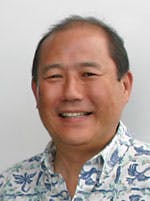Step off the aircraft to be greeted with ardent salutations and adorned with the essence of tropical orchids and in an instant you will understand Aloha, experience Kokua and know Ohana. But what you won't realize until you speak with the people who live and work in Hawaii; this is not just a way of welcoming visitors, but a way of life.
Initially, this article with Ken Best, Aloha's vice president, cargo and contract services, was going to be about Aloha Airlines and its significance to the state of Hawaii. However, having had the opportunity to also meet with Tom Anusewicz, executive vice president of Bradley Pacific Aviation and Neil Takekawa, president of Island Air, I learned that one of the key elements in ground support and aviation in Honolulu is the importance of cooperation and the feeling of family among everyone.
A History Connected
Aloha Airlines
For more than 35 years Aloha Airlines, formerly Trans-Pacific Airlines, has been providing ground handling at the international terminal in Honolulu, cargo having been one of its predominant operations with international carriers such as China and Korean.
But according to Best, it was in 1988 that Aloha's Howard Oshita, director of contract services (now retired), came on board determined to grow contract services and capitalize on the opportunities. "Then the big change really occurred in 1999 when we took over Signature Flight Support, increasing the size of the contract service business by at least sixty percent, maybe more," states Best.
Since then there's been a steady growth as carriers reduce costs. Currently,
Aloha is the largest provider of contract aviation services in Hawaii, providing
services for more than twenty domestic and international air carriers and handling
more than 85 percent of the state's interisland
air freight business.
Island Air
Part of Aloha Airgroup Inc., (parent company to Aloha Airlines) for more than fifteen years, Aloha Island Air became an independent company in May of 2004 and changed its name to Hawaii Island Air, which is locally known as Island Air. "Going forward, part of the deal was to retain every employee," proudly proclaims Takekawa. "When the transfer happened we had about 220 employees; pilots, mechanics, check-in personnel." Island Air now has 340 employees, who, because it is a smaller operation, are cross-trained. Island Air continues to work with Aloha, contracting out reservations and accounting operations.
Bradley Pacific Aviation
Bradley Pacific, a young company and primarily a fuel service operation is the into-plane agent for a good percentage of the airlines in Honolulu and the main fueler on all of the other islands. "We rolled in a trailer and hung out our shingle," claims Anusewicz. "But all of the airports are state owned and having lived here for over twenty years, knowing who to go to and how to get things done certainly helped build the foundation." According to Anuscewicz, who's been in the islands for more than 22 years and in aviation for 37, Bradley Pacific's market share has increased dramatically in the seven years it's been operating, as has the volume of direct flights to the outer islands that need to be serviced.
Island Hopping
Aloha Airlines has four stations in contract services with its strength and home base being the state of Hawaii in Honolulu, Maui, Kona and Kauai. They currently have more than 1,200 part and full-time employees with the classification for below wing of "contract services." There are fewer above wing classification employees, known as contract service agents.
According to Best, Aloha's key services include passenger check-in, passenger services, cleaning, ramp, aircraft maintenance and cargo. "We are particularly strong in the area of ramp and cleaning. In Honolulu we are one of the top stations for Continental, which we picked up in 1997. A year ago we contracted cabin cleaning from United and just received an award."
Island Air's Takekawa says he is trying to fit "in-between" by scheduling flights on the fringe times, which are later in the evening after the other carriers have stopped flying. This schedule creates more flexibility for the business person who, after arriving in Honolulu, can fly to Maui, Kauai, Hilo or Kona, perform sales calls, take a client out to dinner and come home. "In the state of Hawaii, the airlines that fly interisland are the "bus service" and it's important to have the frequency." People on the mainland or even the larger islands of Hawaii and Oahu, take for granted going to a medical appointment, purchasing a vehicle or eating at a fast food restaurant. In the smaller islands of Lanai and Molokai, you need to catch a flight for most medical needs, major purchases and Big Macs. "The standard joke for the people of Lania is 'next time you go can you bring back a Happy Meal?'," says Takekawa.
As an FBO, Bradley Pacific operates in five locations which include Honolulu, Hilo and Kona and on the Big Island, Kauai and Maui. They handle any aircraft that has the capability to make it all the way to the Pacific and they maintain at least one or two each of the necessary GSE at each location as well as 37 pieces of fueling equipment. Anusewicz works with both new and used equipment when it comes to GSE. We buy some used GSE equipment, tugs and GPU's, much of it "as is," just to get the carcass. We are able to take it from there and do it cheaper," remarks Anusewicz. "We've picked up a few things in trade. We also talked to Aloha about Bradley fueling their aircraft primarily on the outer islands." Bradley Pacific acquired Aloha's old trucks and put them back into service, however, for the most part, they try to purchase their refuelers new. The fuel trucks for Maui, a five-million-gallon a month operation, were custom built for the public roads due to lack of airport storage. Currently they own six 10,000 gallon refuelers and just bought two 5,000 gallon refuelers.
Because of the infrastructure on the Big Island of Hawaii, all of the fuel that is barged from Oahu first goes to the Hilo terminal and then thirteen 8,000 gallon loads a day are trucked three hours along the coast to the fuel farm managed by Bradley. "For 20,000 gallon plus uplift for one 777 departure, more than two trucks have to be on the road at the right time to get it to the airport," explains Anuscewicz.
Growing Together
Ironically, during the last three-year slump for the mainland, Hawaii has been a growth market since 9/11. "In fact," recalls Anusewicz, "We (Honolulu) came back quicker than any city in the nation as far as the flight schedule and we just kept increasing." There was great concern about traveling to foreign countries, so Hawaii, though always a popular tourist destination became an exemplar location. "You might say it's been a growth market for many years because it's Hawaii," says Aloha's Best. The Asian market grew for many years until the bubble burst in the early '90s. There has been gradual growth from the mainland, but according to Best, the big change has been the growth in direct flights to the outer islands.
For example, American Airlines, for which Aloha does all of the handling, had only one flight into Maui in 1998. Today they are doing 6 to 7 flights a day to Maui and two flights a day to Kona and Kauai. "What we are dealing with is a lot of farming out by the airlines, creating growth for our business in the past five years and also the challenge to effectively manage it through intense communication and reporting with our clients," says Best. There is only one American Airlines key liaison who visits Aloha's stations on a regular basis. Each station is solely operated by Aloha employees.
Within five short months, Island Air went from a fleet of four 37-seat aircraft to nine and opened three additional airports beyond the five they were already at, thus flying to every destination in the state of Hawaii. "Along with that," says Takekawa, "we started with 44 flights a day and we are up to 96 flights a day now. What we are trying to do is take the routes and link the cities in the low density locations." One example of the cooperation between one another is the agreement Takekawa has with Aloha, Hawaiian and United to fly the direct routes within the state. This also makes perfect sense for passengers whose flight time has decreased by almost two hours because they no longer have to go through Honolulu. "From day one we have already said that we have no desire to be competitors with them, in essence we are, but what we want to be is complimentary in the marketplace."
Initially, the most important issue for Bradley Pacific was securing quality employees, equipment, and training. To put resources into costly facilities was not the priority.
Anusewicz will tell you that the FBO business is a little bit different in Hawaii. On the mainland, FBOs need to have larger facilities because they are catering to pilots that have to be there to wait for their passengers. Understandably, most people making the trip to Hawaii will plan to stay; therefore, FBO facilities are not always needed. "But we positioned ourselves to grow and now we are getting ready to build a 40,000 squar-feet hangar in Kona," says Anusewicz. In Maui, though they will not build new for another couple of years as they have moved into an older facility just last year and reconditioned it. In Honolulu they are working with a bankruptcy court on another FBO, Century Aviation, which has been in bankruptcy for some time.
Corrosion control prevention is another opportunity for growth for Bradley because the corrosion factor for equipment is so prevalent due to the salt air. Due to the expansion of EPA regulations, they are now in the development stage for a new maintenance area that will house a paint booth, which can fit a 10,000-gallon truck. "If we get the approval to put it in we will certainly have the area to take care of others," says Anusewicz. "It only makes sense either to do their painting or allow them to do their painting and be able to pay for our investment."
A Word About Ohana
Ken Best:
There's a commitment, there's a feeling here, family, the term
is used OHANA. People are committed to this state. Most of the people that
work in contract services are locals, born and raised here and there's
a level of bonding. People think in terms of how they can help each other work
as a team.
Neil Takekawa:
We all work together as a team. This is an island mentality. We are very competitive
with each other but we still need to work with one another. For example,
I buy my fuel through Bradley and I'll do my own into-plane, but in
the neighboring islands I'll contract with him to do everything.
Tom Anusewicz:
As Neil said, we do work together because everybody's going to have their
day that doesn't work out. Our role on the ramp is if our neighbors need
something, be there for them because tomorrow you'll be knocking on their
door. And because of the cost of the equipment, if there's an opportunity
we try to share. The airlines are on the edge and they are trying to keep their
costs down so if we can do the same, it makes more sense for us. Some airlines
are struggling more than others and they all are trying to keep their costs
down so if we can do the same, it benefits us all.





